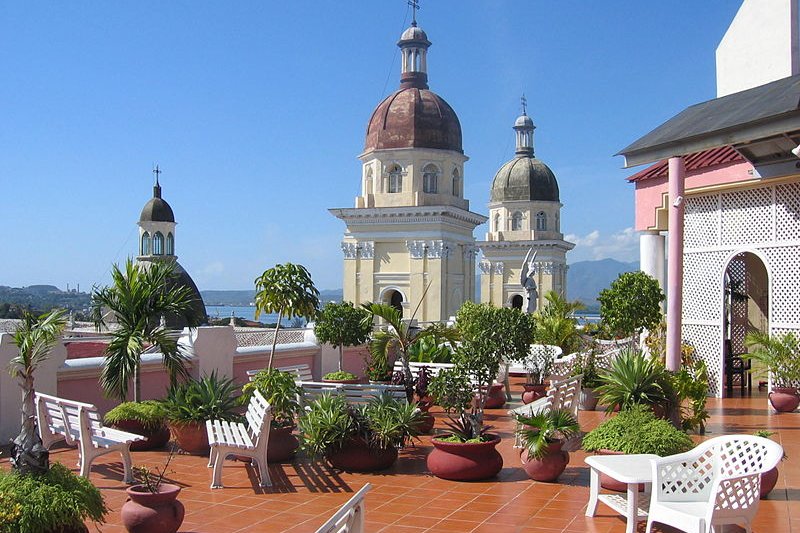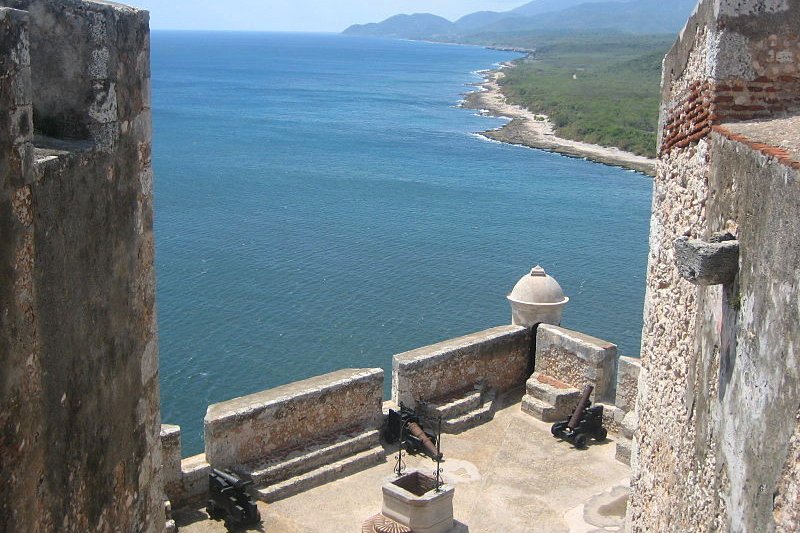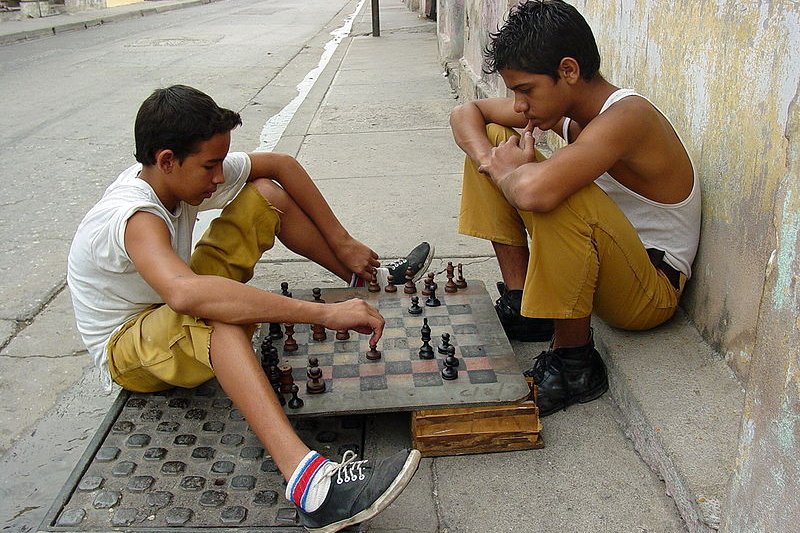 Casa Grande Hotel, Santiago de Cuba
Casa Grande Hotel, Santiago de CubaSource: https://commons.wikimedia.org/wiki/File:DirkvdM_casa_grande_roof_terrace.jpg
Author: Dirk van der Made

Santiago de Cuba is the second largest city in Cuba. Founded by Spanish conquistador Diego Velázquez de la Cuéllar in 1514, Santiago de Cuba today covers 1,023.8 sq km (395.3 sq mi) and has a population of 472,000 (2011 estimate).
Santiago de Cuba served as the launch pad for Spanish expeditions to discover the New World, with Juan de Grijalba and Hernán Cortés setting off for Mexico in 1518 while Hernando de Soto heading for Floria in 1538. The city itself had a rocky start. It was destroyed in a blaze in 1516 while man-made calamity in the form of plunder by the French beset it in 1553, and by the British in 1662.
The Cuban Revolution had its start in Santiago de Cuba, albeit with the unsuccessful attack on the Moncada Barracks by a small group headed by Fidel Castro in 1953. The city was the home of Cuban revolutionary hero Frank País,. Santiago de Cuba was where Castro proclaimed the victory of the revolution in 1959.
 Castillo del Morro, San Pedro de la Roca, Santiago de Cuba
Castillo del Morro, San Pedro de la Roca, Santiago de CubaSource: https://commons.wikimedia.org/wiki/File:Castillo_del_Morro_near_Santiago.JPG
Author: Escla

Culture wise, Santiago de Cuba is regarded as the most African and the most music-inclined city in Cuba. As with Havana, the city has managed to preserved (perhaps out of lack of funds) much of its early 20th century architecture.
Santiago de Cuba experiences a hot and humid tropical climate with fairly constant temperatures. The middle part of the year, from July to September, is the warmest, when the average high temperature rises to 30.6°C (87°F). Coldest months are January and February, when the average low drops to 21.1°C (70°F). October receives the most rain, at 193 mm (7.6 in).
 Boys playing chess on a sidewalk in Santiago de Cuba
Boys playing chess on a sidewalk in Santiago de CubaSource: https://commons.wikimedia.org/wiki/File:Children_Playing_Chess_on_the_Street_-_Santiago_de_Cuba_-_Cuba.jpg
Author: Adam Jones

Visiting Santiago de Cuba
You can fly to Santiago de Cuba from Havana. There are also trains and buses going there from Havana as well as from Camagüey and Santa Clara.Sights & Attractions in Santiago de Cuba's Historic Center
- Balcón de Velázquez
A view point offering fantastic views of the city. - Calle Heredia
The most popular and probably liveliest street in Santiago de Cuba. - Casa de Diego Velázquez (Museo de Ambiente Histórico Cubano)
According to some (but disputed by others) this is the oldest private home in Cuba built in 1516 as the residence of governor Diego Velázquez. It has a long and fascinating history where it was used for various purposes. Today it houses a museum on the history of furniture in Cuba. - Casa Natal de José María Heredia
House where the namesake nationalist poet was born in 1803. The house has been preserved with peirod furniture of the early 19th century. - Catedral de Nuestra Señora de la Asunción
This is the cathedral of Santiago de Cuba. Originally built in 1522, it has since been rebuilt a number of times. It has its own museum, the Museo Eclesi´stico, which exhibits Catholic religious objects. - Museo de la Lucha Clandestina
Once the Batista police headquarters, it was set upon and burnt down by revolutionaries headed by Frank País. Since then, it has been rebuilt, restored, and made a museum to recount the activities of the movement headed by Frank País. - Museo del Carnaval
Built in the late 18th century, this charming building has served different purposes before being converted in 1983 to explain and celebrate the Santiago Carnival. - Museo del Ron
Museum celebrating rum, showing how it is distilled and matured. - Museo Provincial Bacardi Moreau
Founded in 1828, this is the oldest museum in Cuba. It displays relics from the Spanish conquest to the war of independence. - Parque Céspedes
The central square of Santiago de Cuba, from where the rest of the city radiates. - Tivolí
A charming cosmopolitan neighborhood whose people hailed from various parts of the world.
Sights & Attractions outside Santiago de Cuba's Historic Center
- Bosque de los Héroes
Monument to Che Guevara and his comrades-in-arms who died with him in Bolivia. - Casa Natal de Antonio Maceo
House where Cuba's great general was born on 14 June, 1845. It today preserves his memorabilia. - San Pedro de la Roca
Acclaimed as the most complete, best preserved example of Spanish-American military architecture, this citadel in Santiago de Cuba is today a World Heritage Site. - Cementerio de Santa Ifigenia
This is the second biggest cemetery in Cuba after the Colón cemetery in Havana. Established in 1868, it is laid out in a Latin cross plan. - Centro Africano Fernando Ortíz
Center celebrating African cultures with display of musical instruments, figurines and masks. - Museo Abel Santamaría Cuadrado - Parque Histórico Abel Santamaría
Historic park named after the coup rebel who was captured and killed by police in the failed raid on the Moncada barracks. The area encompasses the barracks, Saturnino Lora hospital and law court buildings. - Museo Histórico 26 de Julio - Cuartel Moncada
Museum recounting the unsuccessful attack on the Moncada barracks. - Parque Baconao
Nature site between the Caribbean Sea and the eastern part of the Sierra Maestra, today a UNESCO biosphere reserve. - Plaza de la Revolución
A large, plain square with the massive statue of General Maceo on horseback. - Plaza de Marte
Third largest public square in Santiago de Cuba, with a 20 m (65 ft) column commemorating Cuban independence. - Vista Alegre
Neighborhood of Santiago de Cuba with lovely eclectic-style buildings from the 1920s and 30s.
 Latest updates on Penang Travel Tips
Latest updates on Penang Travel Tips
 Discover with Timothy YouTube Channel
Discover with Timothy YouTube Channel
 PG Food Channel
PG Food Channel
 Learn Penang Hokkien YouTube Channel
Learn Penang Hokkien YouTube Channel
 SojiMart Videos
SojiMart Videos
Latest from Discover with Timothy: Gurney Bay - what to see and do there
About this website

Hello and thanks for reading this page. My name is Timothy and my hobby is in describing places so that I can share the information with the general public. My website has become the go to site for a lot of people including students, teachers, journalists, etc. whenever they seek information on places, particularly those in Malaysia and Singapore. I have been doing this since 5 January 2003, for over twenty years already. You can read about me at Discover Timothy. By now I have compiled information on thousands of places, mostly in Peninsular Malaysia and Singapore, and I continue to add more almost every day. My goal is to describe every street in every town in Malaysia and Singapore.
Robbie's Roadmap
- Episode 1: Robbie's Journey to Financial Freedom
- Episode 2: Lost in America
- Episode 3: The Value of Money
- Episode 4: The Mentor
- Episode 5: The Thing that Makes Money
- Episode 6: The walk with a Billionaire
- Episode 7: The Financial Freedom Awakening
- Episode 8: Meet Mr Washington
- Episode 9: The Pizzeria Incident
Copyright © 2003-2024 Timothy Tye. All Rights Reserved.


 Go Back
Go Back